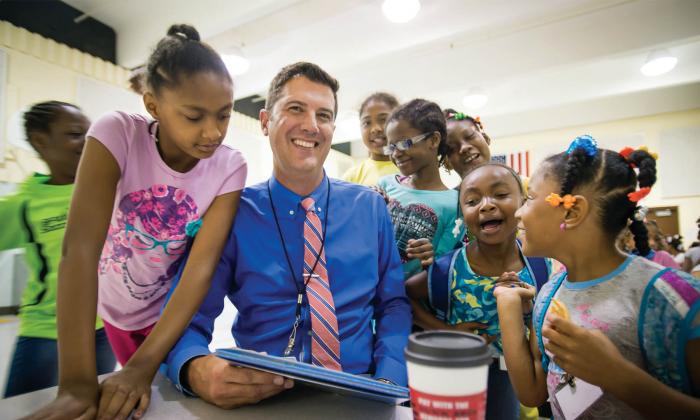Brian Siverson-Hall is the executive director of community engagement for Osseo Area Schools, Minnesota, and the president of the Minnesota Community Education Association. To say he wears many hats is an understatement, but regardless of which part of his job he’s doing, Siverson-Hall is always trying to move the needle on racial equity and to help other educators do the same.
How have you helped your district work toward equitable school experiences for students?
All of the leaders in the school district … developed our own personal racial equity purposes. For me, my purpose is as a leader for racial equity. I believe all students and community members have the right to opportunities in education that will enable them to achieve their dreams and become their best selves. Therefore, I intend to isolate race and seek multiple perspectives to learn what opportunities are most salient to various racial groups. I will ask myself and those I work with to be mindful of our strategies to ensure there is no predictable pattern to participation or success in community ed. programs by race.
How do you get other stakeholders in Osseo committed to racial equity?
[T]his is adaptive work, not technical work. It is not like there is one thing you can do to say, “All right, if we do this one thing then tomorrow we will completely close the racial achievement gap,” for example.
There are some folks in our organization who think we’re moving too quickly in this work, and then there [are] others who believe we need an even greater sense of urgency because we only have young people for a limited amount of time. When I am thinking about this, one of our most important things to do is create the conditions that are most likely to keep us in a productive zone at the heart of adaptive change. [O]ne of the ways to get other stakeholders committed to the work is to model what it means to be both a learner and a leader at the same time.
What have been important shifts or milestones in your racial equity work?
[One milestone] was … helping to plan our first community forum on race last year, and then following it up with our second annual forum just this past May. We worked with a couple of community colleges, as well as our K-12 system and some faith-based groups, to provide this forum. I would say, for me, this was a visible way for me to step out in my leadership around racial equity. These forums really allowed me to hear multiple perspectives and the counter-story of people whose voices traditionally are often marginalized, unfortunately, in the education setting. The thinking behind it was, especially the first time, to give people some tools [for] how to have conversations about race in their own community so they could do that as an individual.
What are markers of success in your work?
[T]here’s multiple markers. Some of the work I’m doing in my own professional development, what I’m seeing with my department I’m leading, and then what we’re seeing as a school district overall. We’ve created [an] eight-person equity team for our [community engagement] department. We devote half of our monthly meetings to professional development around equity, as well as participating in the equity team training that takes place at our school district level with all of the building-site equity teams. All of our partnerships with various community agencies, I think, are also markers of success to me.
We’ve really had some amazing success when it comes to graduation. For the state of Minnesota [in 2014], white students graduate at about 86 percent on time and at Osseo we are [at] 92 percent. Asian students: 82 percent, Osseo 91 percent. [Kids receiving] free-or-reduced lunch: Minnesota state averaged 66 percent, Osseo 77 percent. American-Indian students: state of Minnesota 51 percent, Osseo 73 percent. Black students: 60 percent statewide, Osseo 71 percent. Hispanic students: 63 percent, Osseo Area schools 71 percent. This is a real testament to the hard work of our teachers, staff and administrators.
What suggestions do you have for educators who want to scale up the changes they achieve at the individual or building level?
Number one is adaptive change. It is a collective set of practices done over a period of time that will lead to success. Number two, I believe administrators are responsible for modeling individual learning while simultaneously leading the work. That goes back to this idea of being both a learner and a leader at the same time and being vulnerable in your own professional development. Last, I would say just be real and authentic with your data and use it as a guidepost from where you are and where you want to be.
If I got to add a bonus one, just keep having resolve in your work. Stay committed to it. You won’t always see rapid change, but also don’t settle for incremental change.
Brian Siverson-Hall is the executive director of community engagement for Osseo Area Schools, Minnesota, and the president of the Minnesota Community Education Association.
Know an excellent administrator, librarian or counselor we should interview?
Tell us all about them.


0 COMMENTS